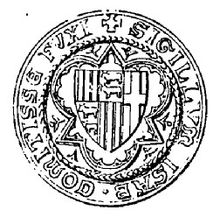Isabella, Countess of Foix
| Isabella | |
|---|---|
| suo jure Countess of Foix | |

Seal of Isabella
|
|
| Reign | 1399-1428 |
| Spouse(s) | Archambaud de Grailly |
| Issue | |
| Noble family | Foix |
| Father | Roger Bernard V, Viscount of Castelbon |
| Mother | Gerauda of Navailles |
| Born | before 2 November 1361 |
| Died | 1428 |
| Buried | Abbey of Boulbonne |
Isabella of Foix also known as Isabella of Foix-Castelbon (before 2 November 1361-1428) was sovereign Countess of Foix and Viscountess of Béarn from 1399 until 1428. She was the daughter of Roger Bernard IV, Viscount of Castelbon and his wife Gerauda of Navailles. She was Countess of Foix in her own right, but shared power with her husband. She succeeded as countess along with her husband upon the death of her childless brother Matthew.
Isabella was the eldest of three children, her two brothers were the aforementioned Matthew and Roger Bernard, who died young. Isabella inherited since neither brothers left children.
Isabella married in 1381 to Archambaud de Grailly. After the death of her younger brother Matthew in 1398, who had tried to claim the Aragonese crown for his wife Joanna; Isabella was last living member of the House of Foix and was heiress of a large ownership which focused especially on the northern slopes of the Pyrenees. This heritage was to be denied to Isabella by the French Crown because of her marriage to Archambaud, whose family had been supporters of the English during the Hundred Years' War. Charles VI of France wanted to prevent Foix from falling under influence of England, so a Royal Army under the leadership of the Constable de Sancerre invaded Foix and occupied large portions. In this situation, Isabella and her husband were willing to submit to the French Crown. The Treaty of Tarbes on 10 May 1399 saw Isabella made Countess as long as her husband stopped his alliance with the English and allow the two oldest sons of the couple to be taken to Royal Court.
The fate of the new Foix dynasty during the French feudal was reflected in its name because Isabella's descendants renounced the leadership of the name and coat of arms of Grailly in favor of the House of Foix's. The loyalty of the new Dynasty of Foix to France was awarded in 1412, when Archambaud was appointed Lieutenant-General of the Languedoc. In 1402 Isabella and her husband arranged the marriage for their eldest son, John to the eldest daughter of Charles III of Navarre, Joan, who was formally recognised as heiress to the Kingdom later that year. This marriage hoped to make a union between Foix and Navarre. However, in 1413, Joan died leaving no issue and John a widower, all hope of a union had now failed.
...
Wikipedia
